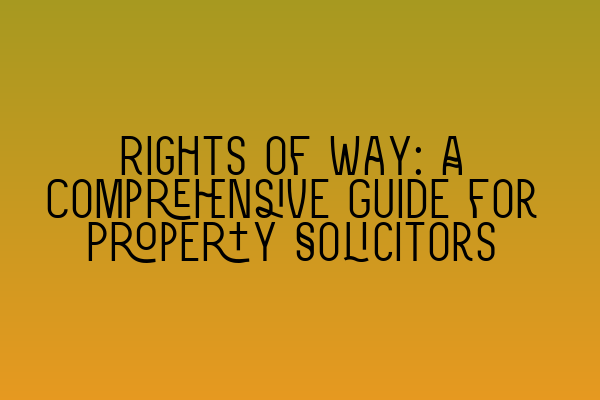Rights of Way: A Comprehensive Guide for Property Solicitors
When it comes to property law, rights of way can often be a point of contention and confusion among property owners. As a property solicitor, it is crucial to have a comprehensive understanding of rights of way and be able to advise clients accordingly. In this guide, we will explore the intricacies of rights of way, including their definition, types, creation, termination, and key considerations for property solicitors.
Definition of Rights of Way
A right of way is a legal easement that allows a person to pass over another person’s land. It grants the right to travel through or across a specified area for a particular purpose. This could include access to a property, a public footpath, or even a driveway for neighboring properties.
It is important to note that a right of way does not grant ownership or exclusive possession of the land. It simply provides the right to pass over it in a specified manner.
Types of Rights of Way
There are various types of rights of way that property solicitors should familiarize themselves with:
- Express Rights of Way: These are explicitly granted by the landowner through a legal document, such as a deed or contract. Express rights of way are often created when a property is divided or when an owner wants to grant access to another party.
- Implied Rights of Way: These are not explicitly granted, but are implied by the circumstances surrounding the land. For example, if a property is landlocked and the only reasonable way to access it is through another person’s land, an implied right of way may exist.
- Prescriptive Rights of Way: These rights of way are acquired through continuous and uninterrupted use of another person’s land for a specific period of time. The length of time required varies by jurisdiction, but it is generally a minimum of 20 years.
Creation of Rights of Way
There are several ways in which rights of way can be created:
- By Agreement: The parties involved can explicitly agree to create a right of way through a legal document, such as a deed or contract.
- By Necessity: If a property is landlocked and there is no other reasonable way to access it, a right of way may be implied by necessity.
- By Prescription: A prescriptive right of way can be acquired through continuous and uninterrupted use of another person’s land for a specific period of time.
It is crucial for property solicitors to properly advise their clients during the creation of rights of way. This may involve drafting clear and comprehensive legal documents and ensuring that all legal requirements are met.
Termination of Rights of Way
Rights of way can be terminated in several ways:
- By Agreement: The parties involved can agree to terminate the right of way through a legal document.
- By Abandonment: If the owner of the dominant property stops using the right of way for an extended period of time and demonstrates an intention to abandon it, the right of way may be terminated.
- By Prescription: If the owner of the servient property obstructs the right of way and the owner of the dominant property fails to assert their rights for a specific period of time, the right of way may be terminated by prescription.
It is essential for property solicitors to guide their clients through the termination process, ensuring that all necessary legal steps are taken to protect their clients’ rights.
Key Considerations for Property Solicitors
As a property solicitor, there are several key considerations to keep in mind when dealing with rights of way:
- Covenants and Restrictions: It is important to review any existing covenants or restrictions that may impact the creation or use of a right of way.
- Land Registry: Property solicitors should conduct thorough searches in the Land Registry to confirm the existence of any rights of way and ensure that their clients’ interests are protected.
- Disputes: Rights of way can be a common source of disputes between neighboring property owners. Property solicitors should be prepared to handle disputes and provide effective resolution strategies, including negotiation, mediation, or litigation if necessary.
Conclusion
Rights of way are a complex area of property law that require careful consideration and expertise. As a property solicitor, it is essential to have a comprehensive understanding of rights of way, including their definition, types, creation, termination, and key considerations. By staying informed and providing knowledgeable advice to clients, property solicitors can ensure that their clients’ rights are protected and disputes are effectively resolved.
For further reading on related topics, we recommend the following articles:
- Misrepresentation in Contracts: Unveiling Deceptive Practices
- A Closer Look at SQE Contract Law Syllabus
- SQE Contract Law: Analyzing Landmark Cases and Influential Judicial Decisions
- Understanding Contractual Capacity: Rights and Limitations
- Interactive SQE Mock Tests for Contract Law: Test Your Knowledge
